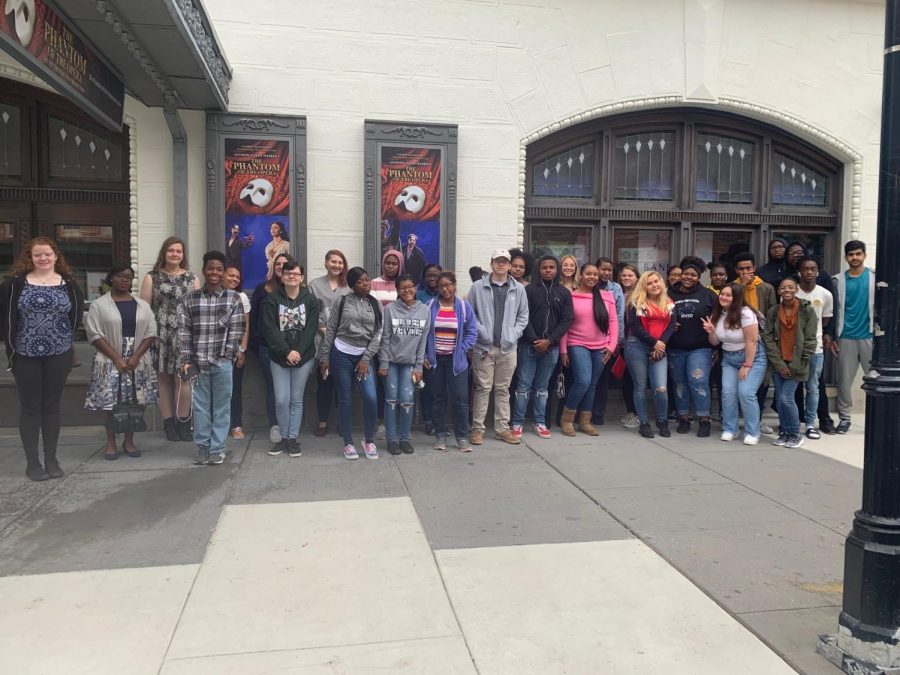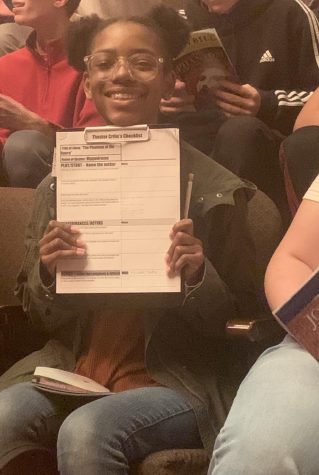Journalism Students’ Review of Phantom of the Opera
October 30, 2019
Kenwood’s Journalism seniors, along with Mrs. Eichelberger’s AP 12 students and Ms. Jannotti’s IB 12 students, had the opportunity on October 16 to visit the Hippodrome to see the Phantom of the Opera. After viewing the show journalism students sat down and engaged in a discussion and analysis with Mrs. Eichelberger’s AP 12 students prior to writing their reviews. As part of that experience the journalism students also met before and after their viewing of the performance with former Baltimore Sun Theater Critic Judy Rousuck to compose their first ever Hippodrome Theater Review. Students had much to say about their viewing of the Phantom of the Opera at the Hippodrome….
If you’re looking for a musical journey that will bring you to tears, even after decades on Broadway, The Phantom of the Opera is the show to see.
The plot is very dramatic and mysterious. Adapted from Gaston Leroux’s classic novel by Richard Stilgoe and Andrew Lloyd Webber, this beautiful yet chilling story is set in 1870 at the Paris Opera House. The Phantom is living beneath the Paris Opera House and has developed a love interest for soprano Christine Daae. He terrorizes the opera cast and management to get Christine star roles. The Phantom hides behind a mask that hides a facial disfigurement. When love interest, Raoul, from Christine’s past, returns, the Phantom sweeps Christine away to his lair. A dangerous love triangle develops. Who Christine will choose keeps the audience captured as the tension among the three escalates.
Andrew Lloyd Webber’s songs and music for The Phantom of the Opera are incredible. From the beginning to the end of the musical, the sound of the piano sent chills down my spine. Its dark and gothic feel in the background and instrumental moments sets the tone for the introduction of the Phantom and the dark twists that take place. One of the crowd’s favorite songs is Masquerade with its cheerful melodies and dark tumultuous undertones. Through the lyrics, the audience is able to see the progression in the characters. For example, Christine’s naïve and hopeful personality in songs like Think of Me and even Angel of Music as she’s drawn by the Phantom show her yearning for him though she sees him as forbidden love. Her character later feels jaded and horrified during the songs Why Have You Brought Me Here? / Raoul I’ve Been There and Act Two’s Notes…/Twisted Every Way. Character progression is even shown through the Phantom’s possessive lyrics and dark and intense theme song. The audience can hear how the Phantom is truly infatuated with Christine and is trying to love her but doesn’t quite know how.
The performance by the Phantom of the Opera cast was exceptional. Derrick Davis is the first African American to play the role of the Phantom on tour. He is captivating in the role of the Phantom and the audience really commended his effort to effectively showcase his role in the play. The Phantom’s goal was to earn the love of Christine and make her stay with him. Davis made the audience believe that the Phantom truly loves Christine despite his sometimes violent behaviors because he feels jealous and betrayed when he sees Christine with another man, Raoul. However, he told Christine to return to him when she was away from him. Davis sang well when Christine first meets him, demonstrating what he wants as her perceived “angel of music.” Davis’ voice, emotion, and body movements made the story look more real and not an illusion. The aforementioned qualities that the actor portrayed kept the audience glued to their seats.
Emma Grimsley gave a beautiful performance as Christine. Christine was a girl who had a beautiful voice, yet as loud as her voice may have been, her character itself was not a loud, assertive female role like some of the other women. The women around her, like opera diva Carlotta Giudicelli and ballet mistress Madame Giry, in a way made her look weak as they were stronger more assertive female characters. Grimsley’s performance was good, but Davis’ performance as the Phantom really was better because his emotions came through stronger as it was obvious he cared very much for Christine. Christine seems to care about the Phantom through her actions, but then in a way she doesn’t and it leaves the audience questioning if she’s wrongly leading him on. But then she kissed him when she saw Raoul nearly being hanged so the Phantom would let him down and not kill him. Christine’s character at times came off as a weak girl as Grimsley presented her as a damsel who needed saving — first by the Phantom to get her roles in the opera and then by Raoul to get her away from the Phantom.
The style is supposed to be a gothic look in order to show the tone of this story. The covered chandelier, the different props on stage that were apart the opening auction scene, and even the “dusty” screen made the stage look like it was supposed
to be the old Opera House.
The designs for the set, backgrounds and costumes are absolutely breathtaking. The chandelier is the pinnacle of the audience’s excitement. From the moment you walk into the auditorium, the chandelier can be seen from all corners of the room. Being placed slightly in front of the stage on the ceiling, it gives the illusion of being a part of the scene, yet interactive. The Hippodrome filled with screams and gasps as it sparked, smoked, and lit up. The scene changes were surprisingly smooth.
As soon as the Phantom is revealed, designer Paul Brown’s revolving set forms a staircase as Christine and the Phantom made their way down to the floor of the stage that is transformed into a lake with dry ice. The use of lighting changes for each character and their personality. Whenever Christine is shown onstage, there’s always a warm light that surrounded the stage while when the Phantom appeared there’s always a dark blue light that would cover the stage.
The Phantom of the Opera was the greatest musical that I have seen and I recommend seeing it to experience this dramatic and beautiful story in person.
This story was republished on the Hippodrome Foundation’s Young Critics Page

